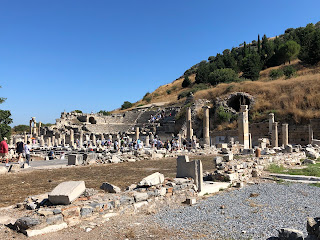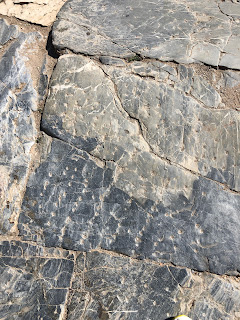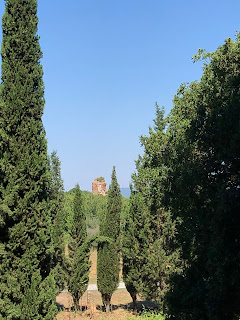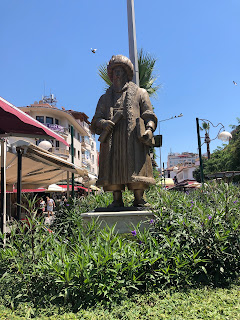The Road Almost Not Taken
We almost skipped going ashore at the Kusadasi/Ephesus port. The notion of visiting Turkey was a bit discomforting, and most of the excursions focused on the Virgin Mary's house. But, after learning about the Celsus Library and the incredible archaeological site at Ephesus, Ned and I decided to give it a go, initially purchasing a four and a half hour excursion through HAL and then trading that in for a more streamlined 3 hour one. The kids opted out of this one and stayed on the ship, sleeping and sunning.
It's fair to say that the Turkish government has put a lot into turning the troubled country back into a cruise ship stop. Due to local unrest, most lines haven't put into port since 2016, which is a lot of lost revenue for a country without many other consistent sources of income. Some lines began returning this year and more will return next year. Perhaps that's why Kusadasi was the only port at which we were welcomed by folkloric dancers, advised that any currency would be accepted ($1 US was roughly 500 dinar), told that there was no crime, and walked off the boat right into the middle of town.

We were told by our guide that those rainbow houses belong to the Romany. Initially the government was going to tear them down, but they did not have alternate housing for the residents living in these makeshift homes. So, the Turkish government let them stay if they painted them to look for like actual houses.

We took a bus for the 30 minute ride to Ephesus, and along the way, we learned that Turkey is pretty much the best country in the world. The weather is perfect; the people are friendly; the agriculture is amazing; the cost of living is very low; there is no graffiti; and there are flags everywhere.

We decided to let sleeping dogs lie and just take in the sights.


Look, it's Mary's house!

One thing that made Ephesus unique from moment one was that visitors were allowed to just climb all over the excavated site, which was pretty amazing.





Ephesus holds so many remnants of history because of its topography. Beginning in 10 BC, Ephesus was a coastal city, but as the Romans departed so did the ability to dredge the harbor with any regularity. This meant it gradually filled in, moving the coastline by miles and covering the then abandoned city of Ephesus with layers of protective dirt for ages. Much of it is still not excavated--intentionally so: exposing it to the elements hastens its deterioration.





As a port city, Ephesus was populated by wealthy merchants who invested in its infrastructure, including a fully functioning sewer system. This marble tile with a circle cut out is actually an early manhole that allowed access to terra cotta pipes (still visible). One of our tour party noted that his rural community wasn't even connected to a sewer system when he was young, let alone in 10 BC.

Check out that sky--it was a clear, hot, and gorgeous day.


Ephesus is organized along a single direction marble road that ran through the heart of the city. It makes keeping tour groups together fairly easy and makes it feel as though you're walking the same journey that Ephesians did each day.



And, of course, there were kitties! Along the long one way marble road through the excavated town, we could hear exasperated guides telling their groups to stop focusing on the cats. When we saw a tight cluster of tourists in any one location, we knew they were fixated not on an ancient ruin but on contemporary feline.




Some of the ruins in Ephesus seemed to be randomly stacked. Like they've found so many things that they're just piling them up in broad categories until they can figure out what to do with them and how they fit together.






Ace photographer


Not so ace photographer--my non-ancient thumb is not part of the tour.

Better.

One of the highlights of the Ephesus tour is the "Terrace Houses," merchant houses which--because of the protective layers of sludge--have retained their lovely mosaic floors. Looking at them, we could imagine the artisans setting each tile just so, hoping for the appreciation of the owners and likely never imagining that over 2,000 years later tourists would be admiring their handiwork.




Again, to think that carvings this delicate survived from the abandonment of the city in 15 AD to today. Among the relics excavated were surgical instruments, again suggesting how advanced the population was at the time.





And then, what we came for: the Library of Celsus. Started by a Roman Senator named Celsus, it. was finished by his son (who included a mausoleum for his father in the building). At the time, it was the third largest library in the world, again suggesting the power and money that used to flow through Ephesus.

The main road of Ephesus ends at the Library of Celsus, giving a sense of the importance of this asset (interestingly, it sits diagonally across from the brothel--below, I'll just leave that there).


The library was destroyed by a fire or an earthquake or Gothic invaders, or some combo of all three and lay in ruins until the facade was restored by German archaeologists. They did a pretty good job.

Again, actual color of the sky.


Ned seen planning the next Friends and Foundation of the Library of Celsus fundraiser.

We wondered about these tracks of indentations on the marble road. Turns out they're for traction. The Romans' leather sandals left them a bit unsteady, too.

Just past the library were the gates that (back in the day) led Ephesus citizens into an open air market on their way to the coast.

A reconstruction of the Ephesian Artemis, who blessed the city with abundance and fertility, shown covered in (I kid you not) bull's testicles. Take that, Met Gala!

After the gates, these pillars stand on the walk to the port and would likely have had some shade covering. Having been to port markets, I can imagine each space filled with vendors selling goods right off the boat: fish, exotic fruits and vegetables, textiles, and more.



Ned, waiting for the shops to open. (Crane is not historically accurate.)

Also willing to bet that this Sharpie Graffiti is not original.

Look at the detail on this column--imagine carving this little by little and seeing the pattern emerge as if by magic.

Super frightening construction sign with the ominous warning: "Once is Enough."

The current reconstruction at the site involves the great theater. Ephesus had two such forums: a smaller one for meetings of the Senators, and this grand theater that could seat 25,000 and was used primarily for entertainment (e.g., gladiator battles, religious rituals, plays). It is massive and gives a good sense of the vitality and riches that were in Ephesus back in the day that they could not just build but also fill such a structure.

On the way out, we passed by a number of excavated tombs, just hanging out together in a field. Again, lots of excavation without a clear sense of what to do with the finds.

Tree friends.

Exiting Ephesus, our next stop was the mandated Turkish rug vendor. On the way, our bus broke down, and our guide somehow summoned two air conditioned mini-buses within about 5 minutes. Turkey gives off an interesting vibe, like it's clear everyone is in on something that you can't see. Everyone is super helpful and pleasant, still something's there.
The courtyard of the rug merchant was filled with the Greek talisman, the Mati or Evil Eye, a "good" evil eye that prevents the actual curse of the evil eye from happening. Kind of like the Greek version of "aloha."

This "HAL approved vendor" (as we were told several times) put on a great show demonstrating how the silk is removed from the cocoons, which are prevented from splitting by setting them out on the patio so that the pupa inside bake in the heat. Speaking of heat, our guide mentioned that it is not unusual for Ephesus to break 115 degrees in the summer--we were in the upper-80s.
The cocoons are dropped in hot water to soften, then with a hand brush, a worker catches the end threads of up to 60, separating them and latching them on to the spooling machine. She worked so quickly and automatically. It was clear she'd been doing this for years. It was hypnotic.



As part of the demonstration, we watched women weaving the rugs. The work is split along bright lines: women make, men sell. Many of the rugs are completed by women in their homes in the very rural hills. Here, the rug maker is using a small sample as at pattern for the larger rug she is weaving.

Then the show began--we all got refreshments. The gentleman in blue is the boss and his workers threw out dozens of rugs--silk, wool, bamboo, and combos. They twirled rugs to show how--because of the weave--they change colors as the light hits them. No prices were shared--because it's all negotiable in Turkey.

I saw a rug I wanted so they took us into another room to look at it up close, and then the negotiating began. Eventually three different managers came in the room, offering more refreshments, offering us not just one rug but two. We only need one, we countered repeatedly (truth, not a negotiating tactic--but it seemed to work as the latter). These will be heirlooms they said; we are not typical Americans they said; have another drink they said; you are very handsome and giving as a husband they said; look the rug won't catch fire they said (holding a bic lighter to it); look us in the eyes they said; take off your shoes and walk on the rugs they said. We only need one rug we insisted. This went back and forth for about 30 minutes. In the end, thanks to our rug fever, we walked out with two gorgeous rugs at 50% off the originally quoted prices with no tax or shipping costs, so probably just around what they should sell for. Honestly, the back and forth was so entertaining that it made the rugs even more valuable to us. Never a culture to give up, as we finalized the paperwork, they asked me what my favorite color was, seeing a case of brightly colored gemstones, I said, "black." They then offered to throw in a black diamond ring at a similarly reduced price. Oh, Turkey. Since most of my jewelry comes from Old Navy, that was an easy pass.


We navigated more evil eyes and jumped back on the bus for a ride into the city.

Grabbed a delicious lunch featuring more smoky eggplant and a nice view of the harbor.



And, of course, a kitty.


With a bit more time on shore before boarding call, we went in search of an authentic Turkish Coffee and meandered through the shops and bazaars of Kusadasi.



Coffee Shop dogs!


Tiny Turkish Coffee: the owner warned Ned not to drink the sludgy grounds at the bottom (their coffee is unfiltered and sweet). About a third of the cup is grounds. I opted for a flat white.

There's probably only about six or seven different types of shops in each bazaar, but they come in multiples of 10s with all the prices being about the same. It made me think that many of them are owned by the same families who stake out different sections of the marketplace just in case tourists only go down one alley.
Well, with the exception of this shop--of which, thankfully, we saw only one.






Store kitty.


We crossed more evil eyes and a post-checkpoint bazaar (including a crowded Starbucks) on our way back to the boat.



Our wonderful day ended on a low note, though, when the Koningsdam failed four times at one meal to bring Harper the gluten/lactose free food we had ordered the night before--and then brushed it off as an accident. After a robust "conversation" with guest services, which included my firm declaration that we would never sail HAL again, we set off for the Lido buffet to pull together a gf meal for Harper. Somehow, the top-level Koningsdam dining supervisor tracked us down to our table in the Lido (we still can't figure out how), and apologized profusely. For the remainder of the cruise, we were invited to use HAL's Club Orange for all meals--an invitation that was followed by phone calls and even another attempt to track us down on ship to personally invite us. So, in the end, even I had to come around and appreciate this level of service--even if it grew out of a massive miss. So, HAL is back in our good graces.



Comments
Post a Comment